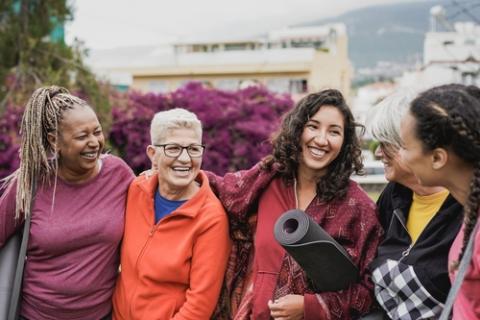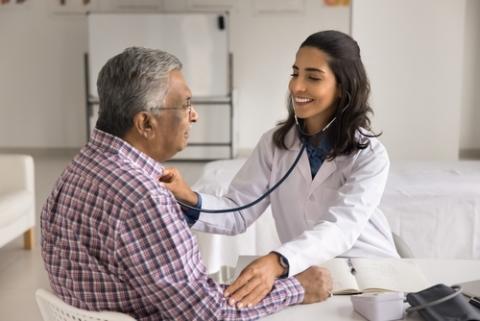America is facing an existential health crisis. Chronic diseases, like heart disease, diabetes, and obesity have been steadily increasing and continue to be some of the major causes of morbidity and mortality in the United States. Racial and ethnic minority populations often carry the heaviest burden.
The U. S. Department of Health and Human Services’ (HHS) call for a healthier Nation aims to reverse chronic diseases and promote wellness by emphasizing health promotion and disease prevention. Recognizing the importance of a multifaceted approach to addressing chronic diseases including a whole-person health lens, this article focuses on practical steps to assist individuals and families of racial and ethnic minority populations on their health journey.
Making Our Diets More Nutritious
What we eat shapes our health. Today, over 50% of calories in the American diet – and nearly 70% of calories for children – come from ultra-processed foods, contributing to chronic disease.1 This must change.
A diet that is rich in nutrient-dense foods such as fruits, vegetables, healthy fats and protein can lower the risk of chronic disease. With creativity and resourcefulness, individuals, families, and communities can access healthy choices and integrate nutritious foods into their diets, even when healthy options do not seem easily accessible. For example, choosing frozen fruits and vegetables instead of fresh can be a more economical choice.
Community interventions can help increase access to whole foods and information about building healthier diets. Examples of interventions include disseminating resource lists of local stores with healthy options and reasonable prices, establishing mobile fruit and vegetable markets, promoting nutritious education and cooking demonstrations, and encouraging urban agriculture initiatives and farmers markets.

Sometimes, small steps can make a big difference. Opting for water over sugary drinks is a simple yet impactful way to make a difference in your everyday routine. Learning to read food labels can help families decide which foods to buy more often and which to take off the list this time. Ingredients to be aware of in food labels include added sugars like high-fructose corn syrup and artificial sweeteners like aspartame and sucralose.2
Move Your Body, Boost Your Mood
Regular physical activity improves energy, mood, and long-term health outcomes. Walks after meals, choosing the stairs instead of an elevator, or even stretching at points throughout the day can have positive impacts on our health. Home workouts and using free videos online are low-cost ways to integrate more exercise into a routine. Finding something you like helps keep up with new habits and build a healthy routine.
Movement with others can bring joy and motivation – dancing at church, walking with neighbors, playing with family, or home workouts. And movement rooted in culture and community can make it easier to maintain.
While some Black and Hispanic adults face certain barriers to exercise (including fewer safe parks and recreation centers), many communities are finding creative solutions. From mall walking groups and church dance ministries to neighborhood walking clubs, people are reclaiming movement in the spaces they have.

Sleep Well, Stress Less
Sleep quality affects mood, immunity, and long-term health outcomes. Addressing sleep is important for minority adults, who report shorter sleep duration and poorer sleep quality.
While some causes of poor sleep are out of our control, creating a calming bedtime routine (such as reading a book), limiting screen time (especially 60-90 minutes before sleeping) and making your sleep space dark and quiet can help. Stress management tools, including breathing exercises, journaling, or mindfulness groups, can also support better sleep. Free meditation and breathwork apps are available as resources to help you get started.
Feed the Spirit, Not Just the Body
Health isn’t only physical. It encompasses body, mind, and spirit. Prayer, meditation, and service to others can foster inner peace, resilience, and purpose.
Racial and ethnic minority communities often have strong spiritual traditions and community networks, which are powerful resources for health and resilience. Research shows that regular participation in faith communities is associated with lower mortality rates and better mental health outcomes, a strength that minority communities draw on.
Being part of something bigger can strengthen both our hearts and our health. Examples include service, celebrating shared traditions, or some other community activity that can bring joy.

Stronger Together: Social Bonds Matter

Community is a powerful medicine. Racial and ethnic populations often have strong traditions of collective support and extended family networks. Such strong social ties can help foster meaning, hope, and resilience while helping to reduce stress and support mental health. Sharing meals, checking in on a neighbor, or joining group events can help strengthen these connections.
Both in times of hardships and well-being, it’s helpful to stay connected. Whether through family, faith, or friendship, investing in relationships is investing in health.
Nature Heals
Spending time outdoors improves focus, reduces anxiety, and helps both kids and adults feel calmer and more grounded. Minority communities are more likely to have less access to green spaces. Despite the challenges, many neighborhoods are creating their own healing spaces through community gardens, transforming vacant lots into peaceful retreats, and organizing walking groups in local parks.
Simple connections with nature can happen anywhere: visiting a local park, taking a sidewalk stroll under street trees, or tending plants on a balcony. Faith-based organizations and community centers increasingly host outdoor gatherings, making nature's benefits more accessible and enjoyable for people.

Prevention Is Power
The dimensions of health explored in this article are foundations of whole-person health and chronic disease prevention. Nutrition, movement, sleep, stress management, community, exposure to the natural world, and spirituality are individually powerful levers for health promotion, and together they have a synergistic impact on long-term health.
Getting regular checkups and screenings are also vital aspects of prevention and health promotion. Through them, health issues are often identified early, before they become serious. But many people skip care due to cost, transportation challenges, or something else.

That’s why it’s important to bring care into trusted spaces: schools, faith-based organizations, barbershops, and community centers. Trusted messengers, like local health workers or community leaders, can help bridge the gap. Free or low-cost screening events, telehealth services, and multilingual education materials can also make a difference. Visit a Federally Qualified Health Center (FQHC), or a Rural Health Clinic for affordable primary care services.
Future posts will dive deeper into some of these areas —sharing tips, tools, interventions, and stories from communities taking charge of their health. Achieving better health and healthy outcomes requires a coordinated, multipronged approach reinforced by systems that prioritize prevention and wellbeing.3 At the same time, individuals, families, and communities can take practical steps in their health journey to combat chronic disease and achieve health and wellbeing. The goal of this article and future posts to the HHS Office of Minority Health Blog is to support lifestyle-based prevention that meets communities where they are and to empower individuals and groups to become protagonists of their own health.
Health isn’t about perfection—it’s about progress. It can start with one step, one meal, one moment of connection. And it grows when we do it together.
Resources:
- FDA’s nutritious initiatives: https://www.fda.gov/food/nutrition-food-labeling-and-critical-foods/fdas-nutrition-initiatives
- Health Centers: https://bphc.hrsa.gov/about-health-center-program/what-health-center
- Find a Health Center: https://findahealthcenter.hrsa.gov/
- Rural Community Programs: https://www.hrsa.gov/rural-health/grants/rural-community
- Rural Health Clinics: https://www.ruralhealthinfo.org/topics/rural-health-clinics
1 The MAHA Report: Make Our Children Healthy Again Assessment. Retrieved July 26, 2025, from https://www.whitehouse.gov (Back to footnote)
2 The MAHA Report: Make Our Children Healthy Again Assessment. Retrieved July 26, 2025, from https://www.whitehouse.gov (Back to footnote)
3 The MAHA Report: Make Our Children Healthy Again Assessment. Retrieved July 27, 2025, from https://www.whitehouse.gov (Back to footnote)
Date Last Reviewed: December 2025

